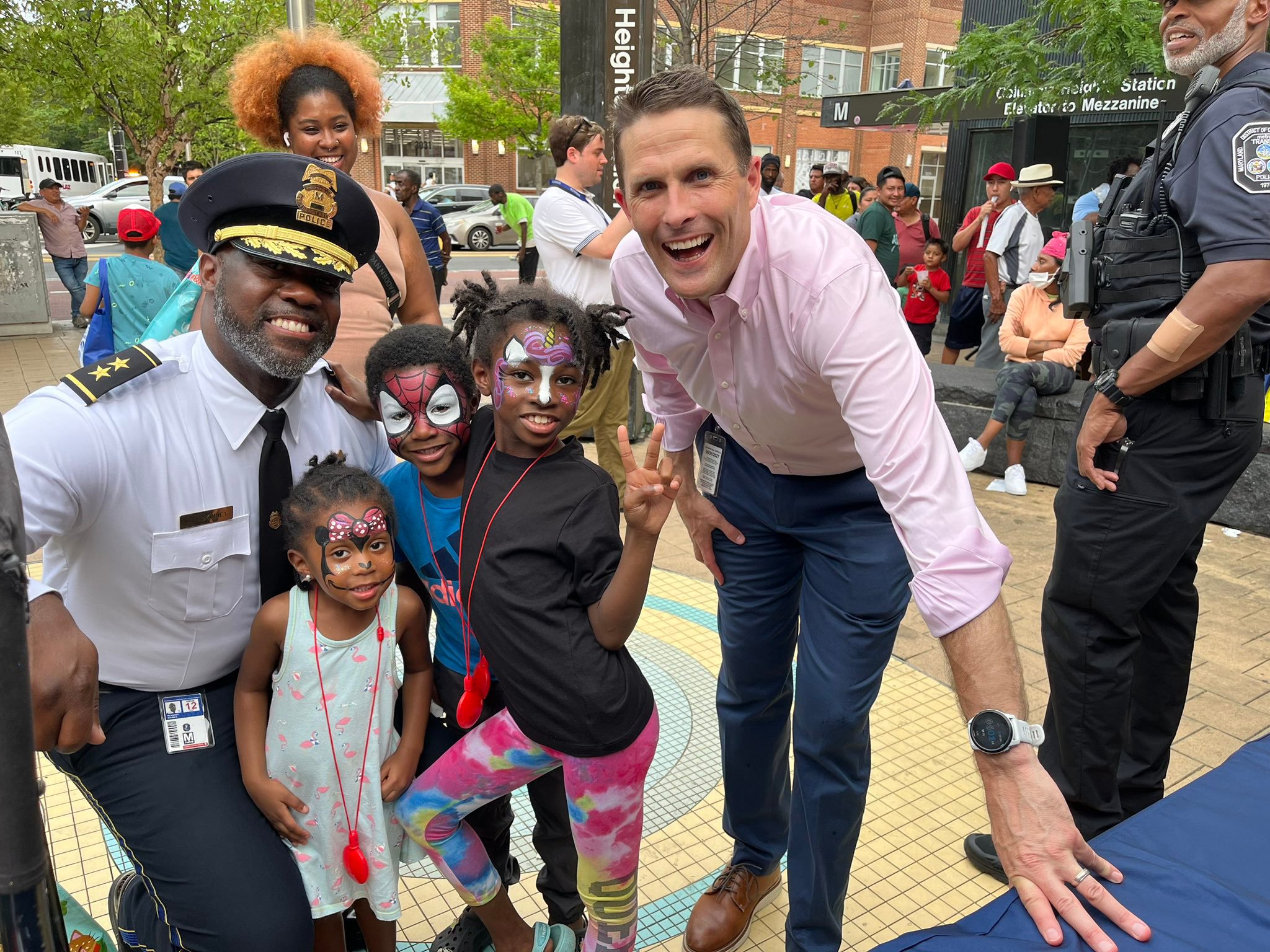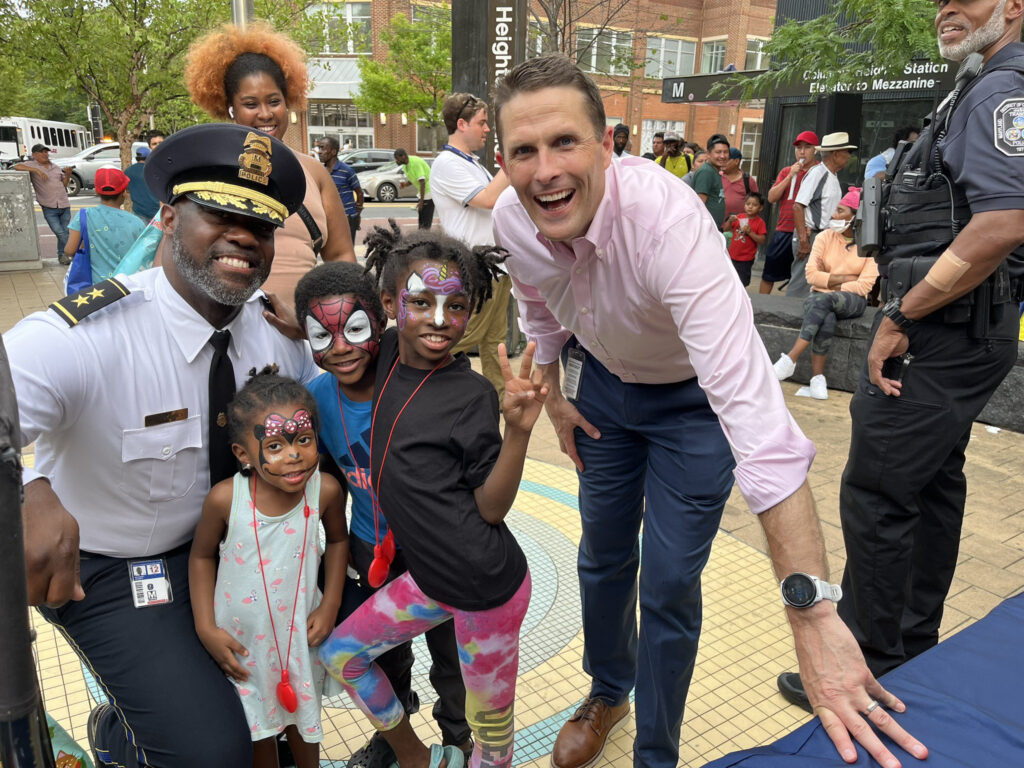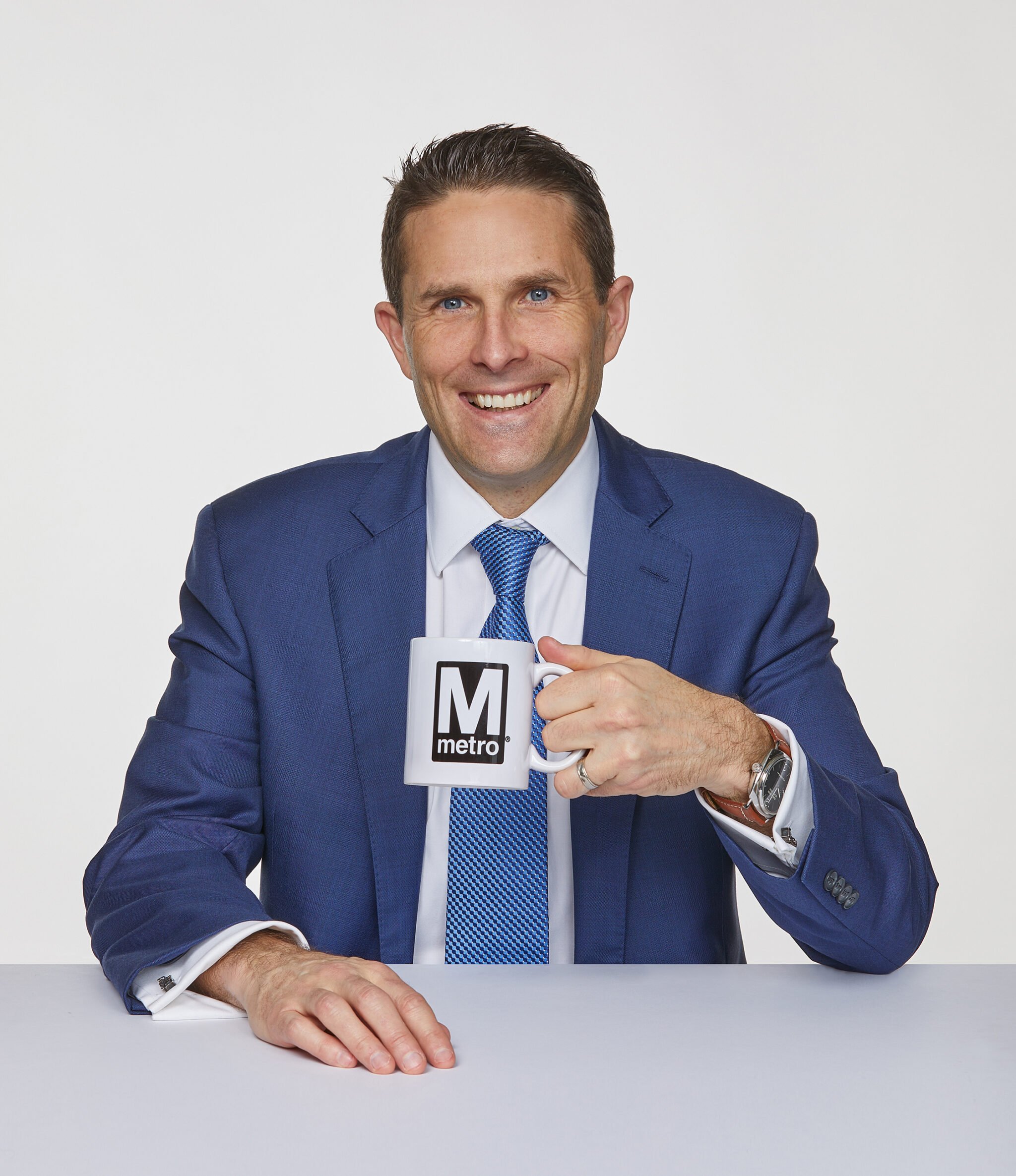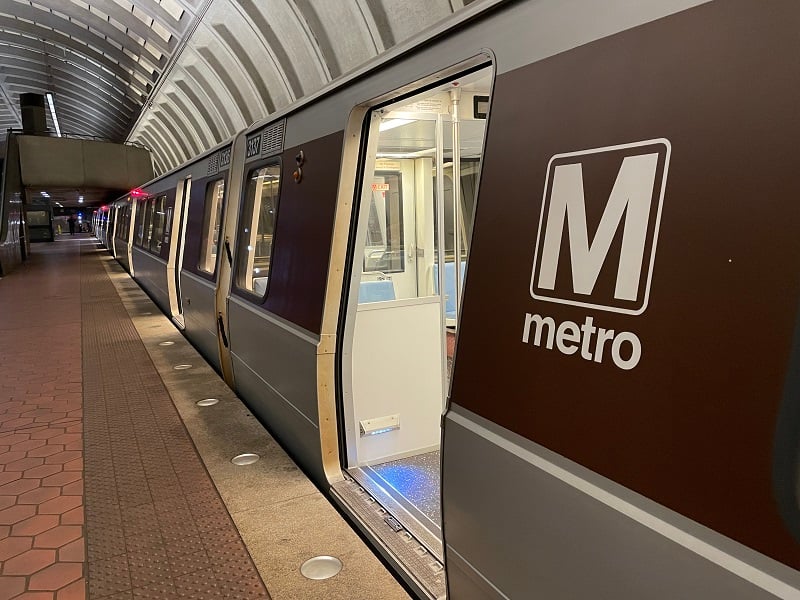The moment Randy Clarke steps off the train at Franconia-Springfield, people start asking for selfies.
“Big fan,” one guy says.
“Can I shake your hand?” a woman asks. “It’s like a celebrity sighting!”
This crowd, here for the inaugural “Metro Fest,” is admittedly self-selecting: hardcore transit fans, train-obsessed kids, bus drivers and their families, the kind of people willing to slather on sunscreen and stand around a Northern Virginia Metro parking lot taking photos of track maintenance gear on a hot Saturday in June.
Still, the level of recognition that Clarke, WMATA’s general manager and CEO since July 2022, has attained among them is remarkable—more befitting a charismatic politician or musician than the head of a transit authority.

With the smattering of Metro employees at the event, Clarke speaks warmly and slightly conspiratorially, as if sharing a secret joke. “When I say your dad’s the man, I mean it,” he says to an employee’s son. “He’s single-handedly taking care of bus shelters.”
The level of recognition Clarke has attained among transit fans is remarkable–more befitting a charismatic politician or musician.
But many of Clarke’s interactions at Metro Fest are with people who might be described as his unofficial fan club. This crowd skews younger—and wonkier. Clarke isn’t their boss, yet some of them seem to know nearly as much about the system as the professionals. One nerdy high-schooler approaches Clarke and immediately gets into the weeds with questions about what will become of the now-retired 2000-series trains, the classic carpeted cars introduced in the 1980s. A group of three friends, all in their twenties, has flown in from Chicago specifically for this event. “DC is setting the stage for transit in North America right now,” says Brandon McFadden, one of the group, who works for American Airlines. They make sure to take pictures with their hero.
After nearly an hour of this, I approach Clarke to ask about the selfie requests and general adulation. Is it typical?
“It’s unbelievable, isn’t it?” he says. “In one way, you must be like, ‘What the hell?’ ”


Of course, the vast majority of Metro riders aren’t like the superfans at Metro Fest. They don’t give much thought to the individuals who run their transit system, and don’t pay much attention to the Metro in general unless things are going wrong.
Right now, things are largely going right.
Across the country, Covid hit public transit hard, as regular weekday commuters and their fare dollars stayed home—some never to return. Yet despite suffering one of the nation’s most precipitous ridership nosedives at the onset of the pandemic, WMATA has led comparable transit systems in recovering, far outpacing BART in San Francisco, the L in Chicago, and the MBTA in Boston, according to the American Public Transportation Association. At various points in the past year, Metrorail ridership has reached 85 percent of its pre-2020 averages, while bus ridership has even exceeded those.

Riders are happier, too. A Washington Post poll this year found that 77 percent of them rate the system as “excellent” or “good,” the highest marks in more than a decade. Many transit advocates credit Clarke with Metro’s rebound. In online circles where bicycles and buses reign supreme, full of tough-to-please urbanists who see cities like Tokyo and Copenhagen as models, he’s singled out for praise. Unlike the heads of some North American transit agencies, Clarke is seen as treating buses and subways as essential to the life of the region—something worthy of serious investment, as opposed to a mere car-commuting alternative that should be managed as frugally as possible.
On the night of Joe Biden’s disastrous debate performance in late June, Clarke happened to have just announced on social media that Takoma station, part of a Red Line construction shutdown, would be reopening ahead of schedule. Replied one user to the news: “Please run for president, Randy.”


Clarke arrived in Washington at a low point for Metro. In July 2022, the Omicron variant was causing a midsummer spike in Covid cases and DC had one of the highest rates of remote work in the country. Bus and rail trips were still stuck at about half their pre-pandemic levels. The previous October, a relatively new 7000-series train had derailed on the Blue Line in Arlington, leading to a rebuke from the National Transportation Safety Board.
Coming at the tail end of Clarke predecessor Paul Wiedefeld’s tenure, these events weren’t quite Metro’s nadir—that was arguably a 2009 Fort Totten crash that killed nine people, or the death of a rider six years later from smoke inhalation inside a train car at L’Enfant Plaza and a subsequent federal takeover of Metro safety. Still, Clarke faced headwinds. Starting in 2021, tens of billions of dollars in federal stimulus had gone to local transit agencies to help them continue to operate. Metro’s share helped the agency avoid major layoffs and service cuts, but the money was just a stop-gap. Transit officials everywhere were in uncharted territory, struggling to plot paths forward.
Unlike many of his now-fans, Clarke didn’t have any particular interest in rail in his youth. Nor did he join the transit world out of idealism. He grew up in Pictou, Nova Scotia, where his parents owned a construction company. It was a tiny, shrinking port town of about 4,000 residents, more than 600 miles from the nearest urban rail systems, in Boston and Montreal.
While working on a master’s degree in public policy at the University of Southern Maine in the early 2000s, Clarke got a summer internship with a local council of governments and was assigned to map out a bus shuttle system for a busy maritime event in Portland Harbor. He started researching bus systems, and had an epiphany: Oh my God, transportation literally connects everything. “Environment, equity, public safety, economic development,” Clarke says. “I mean, we touch everything.”
Clarke’s first job out of grad school was at the Volpe National Transportation Systems Center, a research arm of the US Department of Transportation based in Cambridge, Massachusetts. A consulting gig with Boston’s transportation authority eventually led to a job as the agency’s chief safety officer, and he was in charge of emergency management during the 2013 Boston Marathon bombing—ahead of the 2014 race, he oversaw a massive MBTA security upgrade. Clarke later spent two years at the American Public Transportation Association, learning the ins and outs of transit policy. He began to feel impatient with the pace of transit projects in the US and frustrated with the low priority many cities place on their trains and buses.
There are two sometimes conflicting areas of public-transportation management: (a) politics, or how to obtain funding and craft policy, and (b) operations, or how to make trains and buses run safely and on time. An effective transit leader has to excel at both. By the time he was recruited to oversee the Capital Metro system in Austin, Texas, in 2018, Clarke had the necessary experience. But Austin was a new world. Boston’s T is the oldest subway system in operation in the United States—its tracks might be well grooved, but at least they’ve all been laid. By contrast, Austin had no subway, just a bus system that was badly inadequate for a sprawling, rapidly growing metro area of more than 2 million people.
An overhaul was needed. Enter Project Connect, a plan to build two light-rail lines, three bus rapid-transit lines, and one commuter-rail line across the city. The project would require $10 billion and the passing of a referendum, an uphill political battle. Before fighting it, however, Clarke focused on improving existing operations. His logic? If current bus and commuter-rail service was more frequent and reliable, the future would be an easier sell. “We had to run the system well to build enough trust to win the referendum,” he says. “That’s what we concentrated on first.”
“He made a very intentional and concerted effort to be the biggest Metro booster you could possibly find. That was a massive departure from the leadership we’d seen before.”
The same day Americans elected President Biden in November 2020, Austinites voted in favor of Project Connect. Its plans have since been scaled back, held hostage by a lawsuit over its funding model filed by Texas’s Republican attorney general. Nevertheless, Clarke says, the referendum proved the city was willing to make a serious investment in transit—and that working to build goodwill can make a major difference, a lesson he has taken to Washington.
“He made a very intentional and concerted effort to be the biggest Metro booster you could possibly find,” says Ward 6 DC Council member Charles Allen, who chairs the Committee on Transportation and the Environment. “That was a massive departure from the type of WMATA leadership we’d seen before. And it started to build the well of community support for tackling big problems.”


To get to Metro Fest, Clarke and I board a Blue Line train at his home station, Foggy Bottom–GWU. He taps his employee SmarTrip card and we head to the platform, where lights are already flashing to announce an incoming train.
A regular rider, Clarke has a commuter’s perspective on Metro—and an executive’s fluency with how it works. Onboard, he tells me about the relative quietness of the system’s tracks (they use massive lengths of continuous welded rail, so they don’t make the loud click-clack of, for example, the New York City subway) and the stretch of track where trains travel fastest (the tunnel between Rosslyn and Foggy Bottom).
Unlike Boston or New York, Washington’s subway still feels like a futuristic system, its aesthetic rooted in midcentury Brutalist hopefulness, like Tomorrowland at Disney World. Optimism drove its construction, and as WMATA laid the system’s roughly 100 miles of track across the region in the 1970s and ’80s, it transformed how we work and live. “You couldn’t build this now,” Clarke says. “I don’t know how in 2024 America we could have the vision to do something like this. It feels like we’ve lost our way a little bit as a country on doing big things.”
When the system is working poorly, Metro can feel dated, even a little sad. But when it’s working well, it’s easy to feel the pride behind its creation. Clarke’s fans credit him with restoring that feeling, and he believes vibes matter. When transit infrastructure is broken and dirty, he says, riders and local politicians get frustrated. They ride less, drive more, and—consciously or unconsciously—devalue the system. By contrast, when trains and buses run frequently and stations feel clean, riders feel more pride and lawmakers believe the system is worth supporting.

When Clarke came aboard, WMATA could have cut back. Instead, the agency hired more operators, increased train frequency on certain lines, and expanded off-peak service to match the shifting commuting patterns of the new work-from-home world. (In a nutshell: weekday ridership down, weekend ridership stable or better.) By last year, Metro was running more train service than at any time in its history.
At the same time, Clarke was becoming the system’s friendly public face. Tall and athletic with gelled hair and bright-blue eyes, he has a somewhat Tom Cruise–like intensity in person. But on social media, his persona is goofy and earnest. He posts dorky selfies from bus rides and Metro platforms. He celebrates veteran train operators, points out new features, and provides construction updates.
Earlier this year, public records uncovered by Atlanta reporters showed that many of the directors of MARTA—that city’s Metro-like train network—seldom use the system. No one can accuse Clarke of the same. While recovering from reconstructive knee surgery after a frightening ski accident last year, he enthusiastically posted about the first time he was able to ride the Metro and buses again. “It’s how I generally get around,” he says. “We have an old used car, but I think I’ve driven it a handful of times in two years, and most of that is taking the dogs somewhere.”

Kai Hall, a policy officer at the nonprofit and advocacy publication Greater Greater Washington and a DC-transit advocate, grew up partly in Tokyo, a city often cited as having the world’s best transit system. He remembers riding the Tokyo Metro and admiring the charming, anthropomorphic mascots it used in its communications and signage. Japan has a penchant for civic mascots—one Japanese rail company even invented a monster that lives in the space between the train and the platform, to encourage kids to mind the gap.
For Metro, Hall says, Clarke plays a similar role. And he’s not alone. Whitney Nichels, WMATA’s vice president of communications, has led the charge on Instagram and TikTok, appealing to the public with lighthearted posts connecting the agency to pop culture. In one video, members of Metro’s communications team ride a subway escalator, spelling out the words of a Chappell Roan song with their arms. In another, a bus operator lip-synchs to Sabrina Carpenter’s “Espresso.”
@wmata We’re in our ✨24-hour bus service ✨ era! Ride with us all night on 14 routes across the District. Plus, courtesy stops between 9 p.m. and 5 a.m. to get you rignt to your door (or your ex’s door 🤷♀️ no judgment!) #wmata #Metro #washingtondc #dcmetro ♬ espresso sabrina – celebs media
The net effect, Hall says, is “energizing a constituency of transit supporters—which you need to be able to tap into when you’re calling for greater investments in the system.”


The hardest part of running WMATA isn’t stopping fare evasion or repairing a handful of extraordinarily long escalators. It’s dealing with a financial structure that some have dubbed the agency’s “original sin.” Unlike most transit systems in other cities, Metro has no dedicated source of funding, such as a sales or property tax. Instead, every year, the agency has to go hat-in-hand to Maryland, Virginia, and the District, asking three jurisdictions with a patchwork of competing interests for the money it needs to operate.
“It’s the most challenging financial-governing model there is in transit,” Clarke says. “There’s no question.”
This model makes it difficult to plan for the future: When you’re essentially a teenager depending on a weekly allowance, and collecting it from Mom, Dad, and a stepparent, it’s hard to determine what to spend on gas today and what to save for new tires in six months. Moreover, decisions that please one of your parents might antagonize another: Two years ago, the DC Council passed a bill that would have given city residents $100 each month toward bus service on a registered SmarTrip card, effectively making bus rides free for District riders. WMATA’s board subsequently asked to delay the program, which now has an uncertain future.
“One of the main reasons that we don’t have [it] is because of individual members of the WMATA board that refused to support that,” says council member Allen, who initially proposed the $100 rider credit. “Their motivations ranged from being afraid of what the costs would be, and that their own constituents were going to ask for the same thing, to just not wanting one jurisdiction to have something that another jurisdiction doesn’t. I couldn’t disagree more with the roadblocks that some members threw up.”
Clarke says he tries “not to be political.” But politics is part of his job. In August, the WMATA board agreed to a new four-year contract with the union representing its workers, drivers, and operators, stipulating modest wage increases and cost-of-living adjustments after the first year. Employee compensation cost the system $1.8 billion last year, and according to Allen, Metro had been under pressure from Virginia Republican governor Glenn Youngkin to keep pay down. “I know [Clarke] has to balance the different political pressures he’s feeling,” Allen says. When Clarke spotted a new AMERICA’S SUBWAY T-shirt for sale at Metro Fest, he turned to a Metro communications staffer.
“Can you remind me to get [Maryland Democratic congressman] Steny Hoyer one of those?” he asked.
Metro, Clarke says, has “the most challenging financial-governing model there is in transit. There’s no question.”
Under Clarke, Metro has done a bit of public lobbying, too. Last winter, WMATA was on the brink of a financial crisis, facing a budget shortfall of $750 million. When local governments were slow to respond, the agency went public, releasing a potential “doomsday budget” that included the elimination of 67 bus lines, the closure of ten Metro stations, and a 10 pm shutdown time for the entire train system. A few months later, DC, Maryland, and Virginia provided $480 million in crucial funding. “By [Clarke] putting that forward, people knew what was at risk,” Allen says.
In April, WMATA’s board approved a $4.8 billion budget that included fare hikes for bus (from $2 to $2.25) and rail (as much as $6.75). While increases helped alleviate the immediate cash crunch—WMATA even announced a year-end surplus of $28 million in its operating budget—long-term problems loom. Rider revenue will likely never match pre-pandemic heights, and in the coming years, annual operating deficits could rise—forcing Metro to cover basic operating expenses by dipping into a shrinking capital fund that’s supposed to cover things like new railcars and buses, station renovations, and track replacement.
DMV Moves, a task force created by the Metropolitan Washington Council of Governments, is scheduled to release a draft plan for a more concrete and reliable source of Metro funding by the end of the year. But how and when such a plan would be enacted remains an open question—and in the meantime, Clarke could end up presiding over cuts that hurt workers and the public alike, putting a severe strain on the good feelings he’s worked to foster.

“It’s easy to enjoy all the selfies when things are going well,” Allen says. “Something’s going to happen at some point that’s not going to go well. How are you ready to respond to that, and be mentally prepared that all those same people that are loving you taking a selfie on the bus are all the same people who are going to start yelling at you about something?”
For now, Clarke is riding high, the closest thing to a rock star local transit has ever known. And he’s not changing his hands-on approach. As he rides the rails, he notes any problems he sees: Recently, he pointed out a broken gate to a station manager, and repairs were soon made. He encourages his subordinates to do the same and wants to launch a program that would allow customers to report maintenance issues spotted during their commutes. For all of his high-profile fan service, the real key to Clarke’s success so far has been the perception among Washingtonians that he’s seriously devoted to the system they ride daily.
“My job is to help people every day, and every day that we waste is a day that we didn’t make a difference in someone’s life,” he says. “That’s a weird way, and maybe a psychotic way, of living your life personally. But life’s short. I want us to make the biggest difference that we can.”
The moment Randy Clarke steps off the train at Franconia-Springfield, people start asking for selfies.
“Big fan,” one guy says.
“Can I shake your hand?” a woman asks. “It’s like a celebrity sighting!”

This crowd, here for the inaugural “Metro Fest,” is admittedly self-selecting: hardcore transit fans, train-obsessed kids, bus drivers and their families, the kind of people willing to slather on sunscreen and stand around a Northern Virginia Metro parking lot taking photos of track maintenance gear on a hot Saturday in June.
Still, the level of recognition that Clarke, WMATA’s general manager and CEO since July 2022, has attained among them is remarkable—more befitting a charismatic politician or musician than the head of a transit authority.
With the smattering of Metro employees at the event, Clarke speaks warmly and slightly conspiratorially, as if sharing a secret joke. “When I say your dad’s the man, I mean it,” he says to an employee’s son. “He’s single-handedly taking care of bus shelters.”
The level of recognition Clarke has attained among transit fans is remarkable–more befitting a charismatic politician or musician.
But many of Clarke’s interactions at Metro Fest are with people who might be described as his unofficial fan club. This crowd skews younger—and wonkier. Clarke isn’t their boss, yet some of them seem to know nearly as much about the system as the professionals. One nerdy high-schooler approaches Clarke and immediately gets into the weeds with questions about what will become of the now-retired 2000-series trains, the classic carpeted cars introduced in the 1980s. A group of three friends, all in their twenties, has flown in from Chicago specifically for this event. “DC is setting the stage for transit in North America right now,” says Brandon McFadden, one of the group, who works for American Airlines. They make sure to take pictures with their hero.
After nearly an hour of this, I approach Clarke to ask about the selfie requests and general adulation. Is it typical?
“It’s unbelievable, isn’t it?” he says. “In one way, you must be like, ‘What the hell?’ ”


Of course, the vast majority of Metro riders aren’t like the superfans at Metro Fest. They don’t give much thought to the individuals who run their transit system, and don’t pay much attention to the Metro in general unless things are going wrong.
Right now, things are largely going right.
Across the country, Covid hit public transit hard, as regular weekday commuters and their fare dollars stayed home—some never to return. Yet despite suffering one of the nation’s most precipitous ridership nosedives at the onset of the pandemic, WMATA has led comparable transit systems in recovering, far outpacing BART in San Francisco, the L in Chicago, and the MBTA in Boston, according to the American Public Transportation Association. At various points in the past year, Metrorail ridership has reached 85 percent of its pre-2020 averages, while bus ridership has even exceeded those.

Riders are happier, too. A Washington Post poll this year found that 77 percent of them rate the system as “excellent” or “good,” the highest marks in more than a decade. Many transit advocates credit Clarke with Metro’s rebound. In online circles where bicycles and buses reign supreme, full of tough-to-please urbanists who see cities like Tokyo and Copenhagen as models, he’s singled out for praise. Unlike the heads of some North American transit agencies, Clarke is seen as treating buses and subways as essential to the life of the region—something worthy of serious investment, as opposed to a mere car-commuting alternative that should be managed as frugally as possible.
On the night of Joe Biden’s disastrous debate performance in late June, Clarke happened to have just announced on social media that Takoma station, part of a Red Line construction shutdown, would be reopening ahead of schedule. Replied one user to the news: “Please run for president, Randy.”


Clarke arrived in Washington at a low point for Metro. In July 2022, the Omicron variant was causing a midsummer spike in Covid cases and DC had one of the highest rates of remote work in the country. Bus and rail trips were still stuck at about half their pre-pandemic levels. The previous October, a relatively new 7000-series train had derailed on the Blue Line in Arlington, leading to a rebuke from the National Transportation Safety Board.
Coming at the tail end of Clarke predecessor Paul Wiedefeld’s tenure, these events weren’t quite Metro’s nadir—that was arguably a 2009 Fort Totten crash that killed nine people, or the death of a rider six years later from smoke inhalation inside a train car at L’Enfant Plaza and a subsequent federal takeover of Metro safety. Still, Clarke faced headwinds. Starting in 2021, tens of billions of dollars in federal stimulus had gone to local transit agencies to help them continue to operate. Metro’s share helped the agency avoid major layoffs and service cuts, but the money was just a stop-gap. Transit officials everywhere were in uncharted territory, struggling to plot paths forward.
Unlike many of his now-fans, Clarke didn’t have any particular interest in rail in his youth. Nor did he join the transit world out of idealism. He grew up in Pictou, Nova Scotia, where his parents owned a construction company. It was a tiny, shrinking port town of about 4,000 residents, more than 600 miles from the nearest urban rail systems, in Boston and Montreal.
While working on a master’s degree in public policy at the University of Southern Maine in the early 2000s, Clarke got a summer internship with a local council of governments and was assigned to map out a bus shuttle system for a busy maritime event in Portland Harbor. He started researching bus systems, and had an epiphany: Oh my God, transportation literally connects everything. “Environment, equity, public safety, economic development,” Clarke says. “I mean, we touch everything.”
Clarke’s first job out of grad school was at the Volpe National Transportation Systems Center, a research arm of the US Department of Transportation based in Cambridge, Massachusetts. A consulting gig with Boston’s transportation authority eventually led to a job as the agency’s chief safety officer, and he was in charge of emergency management during the 2013 Boston Marathon bombing—ahead of the 2014 race, he oversaw a massive MBTA security upgrade. Clarke later spent two years at the American Public Transportation Association, learning the ins and outs of transit policy. He began to feel impatient with the pace of transit projects in the US and frustrated with the low priority many cities place on their trains and buses.
There are two sometimes conflicting areas of public-transportation management: (a) politics, or how to obtain funding and craft policy, and (b) operations, or how to make trains and buses run safely and on time. An effective transit leader has to excel at both. By the time he was recruited to oversee the Capital Metro system in Austin, Texas, in 2018, Clarke had the necessary experience. But Austin was a new world. Boston’s T is the oldest subway system in operation in the United States—its tracks might be well grooved, but at least they’ve all been laid. By contrast, Austin had no subway, just a bus system that was badly inadequate for a sprawling, rapidly growing metro area of more than 2 million people.
An overhaul was needed. Enter Project Connect, a plan to build two light-rail lines, three bus rapid-transit lines, and one commuter-rail line across the city. The project would require $10 billion and the passing of a referendum, an uphill political battle. Before fighting it, however, Clarke focused on improving existing operations. His logic? If current bus and commuter-rail service was more frequent and reliable, the future would be an easier sell. “We had to run the system well to build enough trust to win the referendum,” he says. “That’s what we concentrated on first.”
“He made a very intentional and concerted effort to be the biggest Metro booster you could possibly find. That was a massive departure from the leadership we’d seen before.”
The same day Americans elected President Biden in November 2020, Austinites voted in favor of Project Connect. Its plans have since been scaled back, held hostage by a lawsuit over its funding model filed by Texas’s Republican attorney general. Nevertheless, Clarke says, the referendum proved the city was willing to make a serious investment in transit—and that working to build goodwill can make a major difference, a lesson he has taken to Washington.
“He made a very intentional and concerted effort to be the biggest Metro booster you could possibly find,” says Ward 6 DC Council member Charles Allen, who chairs the Committee on Transportation and the Environment. “That was a massive departure from the type of WMATA leadership we’d seen before. And it started to build the well of community support for tackling big problems.”


To get to Metro Fest, Clarke and I board a Blue Line train at his home station, Foggy Bottom–GWU. He taps his employee SmarTrip card and we head to the platform, where lights are already flashing to announce an incoming train.
A regular rider, Clarke has a commuter’s perspective on Metro—and an executive’s fluency with how it works. Onboard, he tells me about the relative quietness of the system’s tracks (they use massive lengths of continuous welded rail, so they don’t make the loud click-clack of, for example, the New York City subway) and the stretch of track where trains travel fastest (the tunnel between Rosslyn and Foggy Bottom).
Unlike Boston or New York, Washington’s subway still feels like a futuristic system, its aesthetic rooted in midcentury Brutalist hopefulness, like Tomorrowland at Disney World. Optimism drove its construction, and as WMATA laid the system’s roughly 100 miles of track across the region in the 1970s and ’80s, it transformed how we work and live. “You couldn’t build this now,” Clarke says. “I don’t know how in 2024 America we could have the vision to do something like this. It feels like we’ve lost our way a little bit as a country on doing big things.”
When the system is working poorly, Metro can feel dated, even a little sad. But when it’s working well, it’s easy to feel the pride behind its creation. Clarke’s fans credit him with restoring that feeling, and he believes vibes matter. When transit infrastructure is broken and dirty, he says, riders and local politicians get frustrated. They ride less, drive more, and—consciously or unconsciously—devalue the system. By contrast, when trains and buses run frequently and stations feel clean, riders feel more pride and lawmakers believe the system is worth supporting.

When Clarke came aboard, WMATA could have cut back. Instead, the agency hired more operators, increased train frequency on certain lines, and expanded off-peak service to match the shifting commuting patterns of the new work-from-home world. (In a nutshell: weekday ridership down, weekend ridership stable or better.) By last year, Metro was running more train service than at any time in its history.
At the same time, Clarke was becoming the system’s friendly public face. Tall and athletic with gelled hair and bright-blue eyes, he has a somewhat Tom Cruise–like intensity in person. But on social media, his persona is goofy and earnest. He posts dorky selfies from bus rides and Metro platforms. He celebrates veteran train operators, points out new features, and provides construction updates.
Earlier this year, public records uncovered by Atlanta reporters showed that many of the directors of MARTA—that city’s Metro-like train network—seldom use the system. No one can accuse Clarke of the same. While recovering from reconstructive knee surgery after a frightening ski accident last year, he enthusiastically posted about the first time he was able to ride the Metro and buses again. “It’s how I generally get around,” he says. “We have an old used car, but I think I’ve driven it a handful of times in two years, and most of that is taking the dogs somewhere.”

Kai Hall, a policy officer at the nonprofit and advocacy publication Greater Greater Washington and a DC-transit advocate, grew up partly in Tokyo, a city often cited as having the world’s best transit system. He remembers riding the Tokyo Metro and admiring the charming, anthropomorphic mascots it used in its communications and signage. Japan has a penchant for civic mascots—one Japanese rail company even invented a monster that lives in the space between the train and the platform, to encourage kids to mind the gap.
For Metro, Hall says, Clarke plays a similar role. And he’s not alone. Whitney Nichels, WMATA’s vice president of communications, has led the charge on Instagram and TikTok, appealing to the public with lighthearted posts connecting the agency to pop culture. In one video, members of Metro’s communications team ride a subway escalator, spelling out the words of a Chappell Roan song with their arms. In another, a bus operator lip-synchs to Sabrina Carpenter’s “Espresso.”
@wmata We’re in our ✨24-hour bus service ✨ era! Ride with us all night on 14 routes across the District. Plus, courtesy stops between 9 p.m. and 5 a.m. to get you rignt to your door (or your ex’s door 🤷♀️ no judgment!) #wmata #Metro #washingtondc #dcmetro ♬ espresso sabrina – celebs media
The net effect, Hall says, is “energizing a constituency of transit supporters—which you need to be able to tap into when you’re calling for greater investments in the system.”


The hardest part of running WMATA isn’t stopping fare evasion or repairing a handful of extraordinarily long escalators. It’s dealing with a financial structure that some have dubbed the agency’s “original sin.” Unlike most transit systems in other cities, Metro has no dedicated source of funding, such as a sales or property tax. Instead, every year, the agency has to go hat-in-hand to Maryland, Virginia, and the District, asking three jurisdictions with a patchwork of competing interests for the money it needs to operate.
“It’s the most challenging financial-governing model there is in transit,” Clarke says. “There’s no question.”
This model makes it difficult to plan for the future: When you’re essentially a teenager depending on a weekly allowance, and collecting it from Mom, Dad, and a stepparent, it’s hard to determine what to spend on gas today and what to save for new tires in six months. Moreover, decisions that please one of your parents might antagonize another: Two years ago, the DC Council passed a bill that would have given city residents $100 each month toward bus service on a registered SmarTrip card, effectively making bus rides free for District riders. WMATA’s board subsequently asked to delay the program, which now has an uncertain future.
“One of the main reasons that we don’t have [it] is because of individual members of the WMATA board that refused to support that,” says council member Allen, who initially proposed the $100 rider credit. “Their motivations ranged from being afraid of what the costs would be, and that their own constituents were going to ask for the same thing, to just not wanting one jurisdiction to have something that another jurisdiction doesn’t. I couldn’t disagree more with the roadblocks that some members threw up.”
Clarke says he tries “not to be political.” But politics is part of his job. In August, the WMATA board agreed to a new four-year contract with the union representing its workers, drivers, and operators, stipulating modest wage increases and cost-of-living adjustments after the first year. Employee compensation cost the system $1.8 billion last year, and according to Allen, Metro had been under pressure from Virginia Republican governor Glenn Youngkin to keep pay down. “I know [Clarke] has to balance the different political pressures he’s feeling,” Allen says. When Clarke spotted a new AMERICA’S SUBWAY T-shirt for sale at Metro Fest, he turned to a Metro communications staffer.
“Can you remind me to get [Maryland Democratic congressman] Steny Hoyer one of those?” he asked.
Metro, Clarke says, has “the most challenging financial-governing model there is in transit. There’s no question.”
Under Clarke, Metro has done a bit of public lobbying, too. Last winter, WMATA was on the brink of a financial crisis, facing a budget shortfall of $750 million. When local governments were slow to respond, the agency went public, releasing a potential “doomsday budget” that included the elimination of 67 bus lines, the closure of ten Metro stations, and a 10 pm shutdown time for the entire train system. A few months later, DC, Maryland, and Virginia provided $480 million in crucial funding. “By [Clarke] putting that forward, people knew what was at risk,” Allen says.
In April, WMATA’s board approved a $4.8 billion budget that included fare hikes for bus (from $2 to $2.25) and rail (as much as $6.75). While increases helped alleviate the immediate cash crunch—WMATA even announced a year-end surplus of $28 million in its operating budget—long-term problems loom. Rider revenue will likely never match pre-pandemic heights, and in the coming years, annual operating deficits could rise—forcing Metro to cover basic operating expenses by dipping into a shrinking capital fund that’s supposed to cover things like new railcars and buses, station renovations, and track replacement.
DMV Moves, a task force created by the Metropolitan Washington Council of Governments, is scheduled to release a draft plan for a more concrete and reliable source of Metro funding by the end of the year. But how and when such a plan would be enacted remains an open question—and in the meantime, Clarke could end up presiding over cuts that hurt workers and the public alike, putting a severe strain on the good feelings he’s worked to foster.

“It’s easy to enjoy all the selfies when things are going well,” Allen says. “Something’s going to happen at some point that’s not going to go well. How are you ready to respond to that, and be mentally prepared that all those same people that are loving you taking a selfie on the bus are all the same people who are going to start yelling at you about something?”
For now, Clarke is riding high, the closest thing to a rock star local transit has ever known. And he’s not changing his hands-on approach. As he rides the rails, he notes any problems he sees: Recently, he pointed out a broken gate to a station manager, and repairs were soon made. He encourages his subordinates to do the same and wants to launch a program that would allow customers to report maintenance issues spotted during their commutes. For all of his high-profile fan service, the real key to Clarke’s success so far has been the perception among Washingtonians that he’s seriously devoted to the system they ride daily.
“My job is to help people every day, and every day that we waste is a day that we didn’t make a difference in someone’s life,” he says. “That’s a weird way, and maybe a psychotic way, of living your life personally. But life’s short. I want us to make the biggest difference that we can.”
This article appears in the November 2024 issue of Washingtonian.








